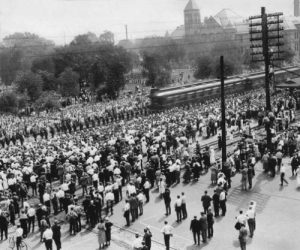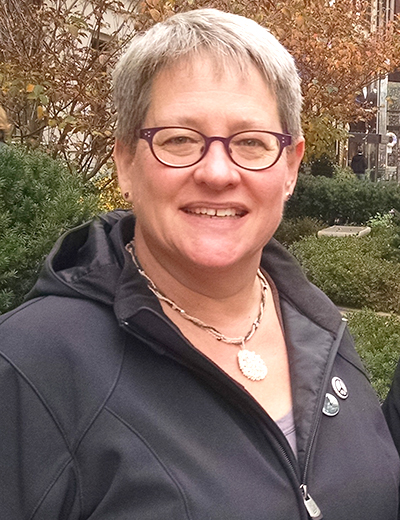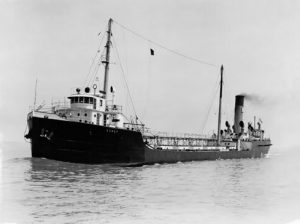 President Warren G. Harding’s funeral train passing through Cedar Rapids, Iowa, on the way to his state funeral in Washington, D.C., August 1923.
President Warren G. Harding’s funeral train passing through Cedar Rapids, Iowa, on the way to his state funeral in Washington, D.C., August 1923.
When writing my last post, I missed an event that Granduncle Fred (Ross W. McCurdy, that’s for you!) mentioned briefly in the many notes he had made. While Fred was “hoboing” his way from the Gulf of Mexico to the Great Lakes, he and his pals happened to be sitting on a coal car in the freight yard at Marion, Ohio, when the body of 29th U.S. President Warren G. Harding arrived for burial in Marion, Harding’s hometown. The President had died suddenly on 2 August 1923 at age 57 while on a speaking tour to San Francisco. Seeing “the entire train draped with black bunting” was a somber moment for Fred and his companions.
Back to Fred in Buffalo in the fall of 1923 working as a deck hand on the Great Lakes steamer Octorara. . . .
Part of the crew’s job was to discharge cargo at each port. At one point on the final trip of the season, the Chief Mate made Fred an offer he couldn’t refuse: a coal passer had just quit; would Fred be interested in taking on that job and getting paid as a deck hand and a coal passer for the few watches that remained? “The work was to trundle coal in a wheelbarrow from the bunkers to the floor plates near the boilers. The fireman then shoveled the coal onto the fires to keep the steam pressure up.” It was the only time in 40 years at sea that Fred worked in the engine room.
Fred must have been feeling full of himself as he collected his bountiful wages and departed the luxury steamer. At least we know his pockets were full, because he decided to purchase a seat inside a passenger train to New York City. He even got a Sunday New York Times to read while he “rode the cushions” as a paying customer. His goal? To get back to the sea as soon as possible and resume his “salt water career.”
By the end of 1923, the 18-year-old Fred was sailing as an A.B., an able-bodied seaman, on coastwise trips—routes that do not involve crossing an ocean, but rather sail up and down the coast. His first trip was aboard the steam tanker Atlas for a wage of $62.50 a month. The list Fred kept of “ships sailed on” includes tankers with a variety of names: Ardmore, Ario, Astral, Comet, Dungannon, Benjamin Brewster, Lio, Malacca, Niobe, Broad Arrow, China Arrow, Dixie Arrow, India Arrow, Japan Arrow, Java Arrow, Standard Arrow, Sylvan Arrow. The Arrows were all owned by the Standard Oil Company of New York, or SOCONY,[1] one of the companies created in the 1911 dissolution of John D. Rockefeller’s Standard Oil Company.[2] Standard Oil’s tankers boasted a fully equipped hospital, accommodations for an average-size crew of 51, and a “spare stateroom.”[3]
About 1927, Fred was in San Pedro, California, a major international port and the base for the U.S. Pacific fleet. He and a buddy went ashore and saw a place that rented Model T Fords. Neither of them knew how to drive, so they approached a Navy sailor and asked if he could teach them. Sailor to sailor, he of course agreed! The Navy sailor drove the car out of the lot for them, briefly explained the various pedals and levers, and then left the boys to it. Each time they stalled, they had to hand-crank the engine. Fred wrote that their top speed was a “delirious 45 mph.” A week later they were sailing through the Panama Canal back to New York.
Fred had “come up through the hawse pipe.”
In 1935, after 12 years’ experience at sea and “intensive study,” Fred passed the written exam for his 3rd mate’s license at the New York Customs House in Lower Manhattan. Unlike some other candidates who had graduated from a maritime academy, Fred had “come up through the hawse pipe” (a pipe in the bow through which the anchor chain passes) as an ordinary seaman. The three-day exam covered “celestial and terrestrial navigation, nautical ‘rules of the road,’ seamanship, cargo handling and stowage, Coast Guard regulations, ship stability, lifeboats and every item that had to be carried in them, and signaling—both by blinker light and international code flags.”
Officer jobs were few and far between in the post-Depression era, however, and it was not until eight months later that Fred would find himself in the right place at the right time, all because of a bucket of water.
To be continued.
Notes
[1] 1922 International Petroleum Register, p. 547.
[2] http://www.visualcapitalist.com/chart-evolution-standard-oil/
[3] Pacific Marine Review, vol. 18, September 1921.
Share this:

About Sharon Inglis
In nearly 30 years in the educational publishing industry, Sharon developed and directed the production of French, Spanish, Italian, German, social studies, science, and math textbook programs for secondary school and higher education. She is very happy to be at NEHGS and applying her editorial and project management skills to Newbury Street Press publications, theMayflower Descendant journal, and whatever else comes her way!View all posts by Sharon Inglis →

